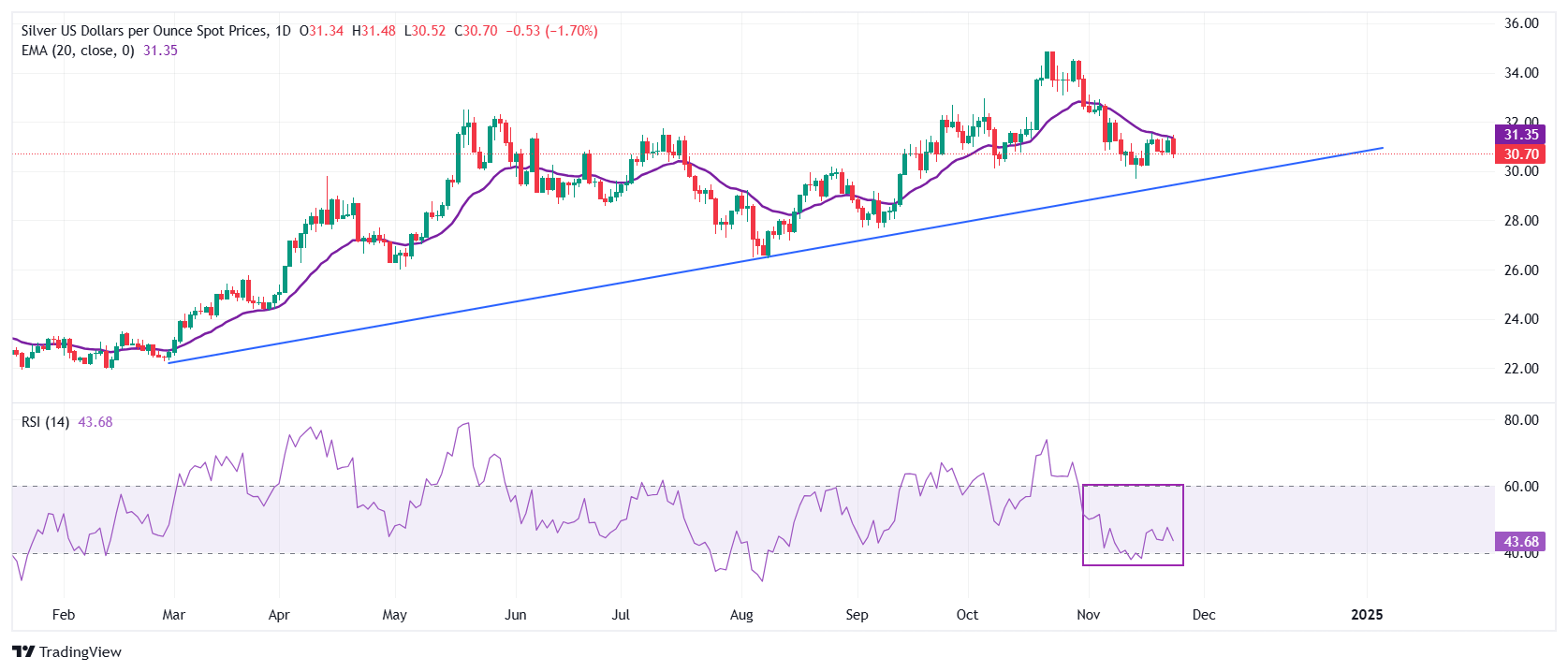Silver Price Forecast: XAG/USD plummets below $31 as US Trump picks Bessent as Treasury Secretary
|
- Silver price falls sharply below $31.00 after Scott Bessent’s appointment as US Treasury Secretary by President-elect Donald Trump.
- The impact of Bessent’s pick was also viewed on the US Dollar and bond yields.
- Investors await the US PCE inflation data for fresh guidance on interest rates.
Silver price (XAG/USD) plunges below $31.00 in European trading hours on Monday. The white metal weakens after the appointment of hedge fund manager Scott Bessent as Treasury Secretary by President-elect Donald Trump.
The market reaction seems to be favoring risk-perceived assets on Bessent’s selection, as S&P 500 futures have posted significant gains in the European session. The US Dollar Index (DXY), which tracks the Greenback’s value against six major currencies, corrects to near 107.00. 10-year US Treasury yields plummet to near 4.33%.
However, his decisions are expected to be supportive of Trump’s policies regarding trade and taxes. Bessent said in an interview with the Wall Street Journal (WSJ) that he would focus on putting tariffs into action, cutting spending, and maintaining the status of the Greenback as the world's reserve currency after Trump picked him as the highest-ranked United States (US) economic official. This could keep the US Dollar (USD) prepared for a sharp recovery.
Trump’s policies are expected to boost US inflation and growth, which could result in fewer interest rate cuts from the Federal Reserve (Fed) in 2025. For the December meeting, traders are divided over whether the Fed will cut interest rates by 25 basis points (bps) to 4.25%-4.50% or leave them unchanged at their current levels.
This week, investors will focus on the US Personal Consumption Expenditure Price Index (PCE) data for October, which will be published on Wednesday. The core PCE inflation, the Fed’s preferred inflation measure, is estimated to have accelerated to 2.8% from 2.7% in September on year-on-year.
Silver technical analysis
Silver price resumes its declining trend after a mean-reversion move to near the 20-day Exponential Moving Average (EMA) around $31.40. The white metal is expected to retreat to the November 14 low of around $29.70. The white metal weakened after the breakdown of the horizontal support plotted from the May 21 high of $32.50.
The upward-sloping trendline from the February 29 low of $22.30 will act as key support for the Silver price around $29.50.
The 14-day Relative Strength Index (RSI) oscillates in the 40.00-60.00 range, suggesting a sideways trend.
Silver daily chart
Silver FAQs
Silver is a precious metal highly traded among investors. It has been historically used as a store of value and a medium of exchange. Although less popular than Gold, traders may turn to Silver to diversify their investment portfolio, for its intrinsic value or as a potential hedge during high-inflation periods. Investors can buy physical Silver, in coins or in bars, or trade it through vehicles such as Exchange Traded Funds, which track its price on international markets.
Silver prices can move due to a wide range of factors. Geopolitical instability or fears of a deep recession can make Silver price escalate due to its safe-haven status, although to a lesser extent than Gold's. As a yieldless asset, Silver tends to rise with lower interest rates. Its moves also depend on how the US Dollar (USD) behaves as the asset is priced in dollars (XAG/USD). A strong Dollar tends to keep the price of Silver at bay, whereas a weaker Dollar is likely to propel prices up. Other factors such as investment demand, mining supply – Silver is much more abundant than Gold – and recycling rates can also affect prices.
Silver is widely used in industry, particularly in sectors such as electronics or solar energy, as it has one of the highest electric conductivity of all metals – more than Copper and Gold. A surge in demand can increase prices, while a decline tends to lower them. Dynamics in the US, Chinese and Indian economies can also contribute to price swings: for the US and particularly China, their big industrial sectors use Silver in various processes; in India, consumers’ demand for the precious metal for jewellery also plays a key role in setting prices.
Silver prices tend to follow Gold's moves. When Gold prices rise, Silver typically follows suit, as their status as safe-haven assets is similar. The Gold/Silver ratio, which shows the number of ounces of Silver needed to equal the value of one ounce of Gold, may help to determine the relative valuation between both metals. Some investors may consider a high ratio as an indicator that Silver is undervalued, or Gold is overvalued. On the contrary, a low ratio might suggest that Gold is undervalued relative to Silver.
Information on these pages contains forward-looking statements that involve risks and uncertainties. Markets and instruments profiled on this page are for informational purposes only and should not in any way come across as a recommendation to buy or sell in these assets. You should do your own thorough research before making any investment decisions. FXStreet does not in any way guarantee that this information is free from mistakes, errors, or material misstatements. It also does not guarantee that this information is of a timely nature. Investing in Open Markets involves a great deal of risk, including the loss of all or a portion of your investment, as well as emotional distress. All risks, losses and costs associated with investing, including total loss of principal, are your responsibility. The views and opinions expressed in this article are those of the authors and do not necessarily reflect the official policy or position of FXStreet nor its advertisers.
